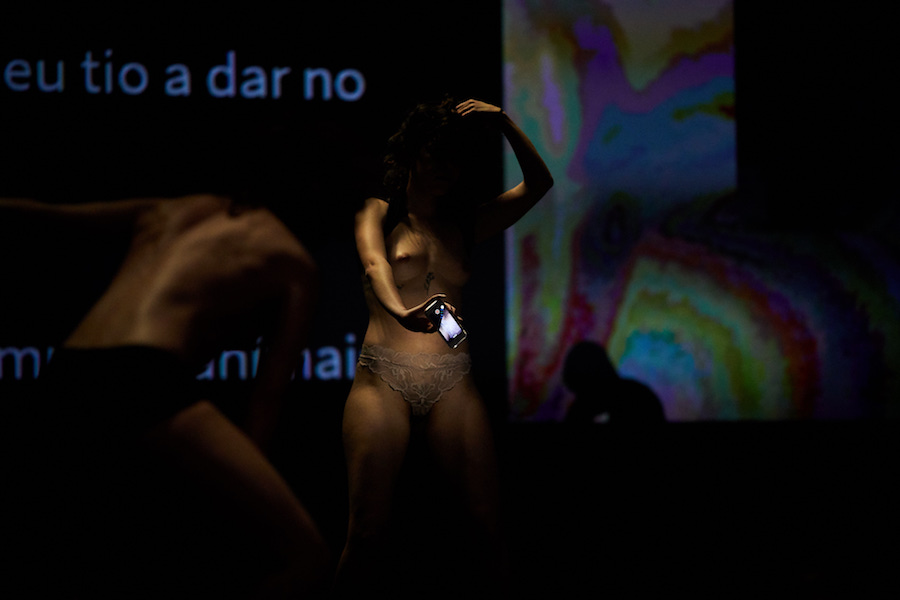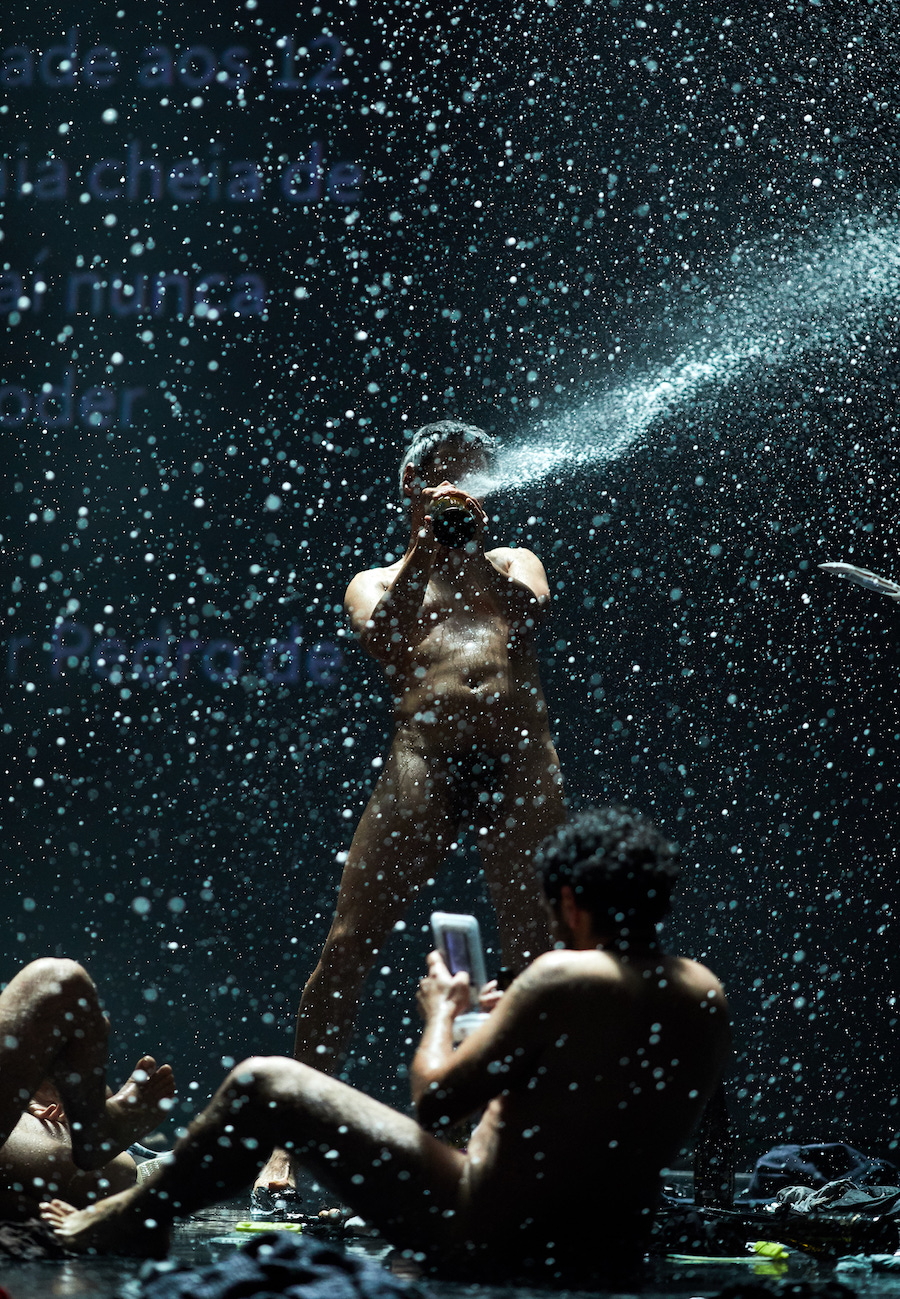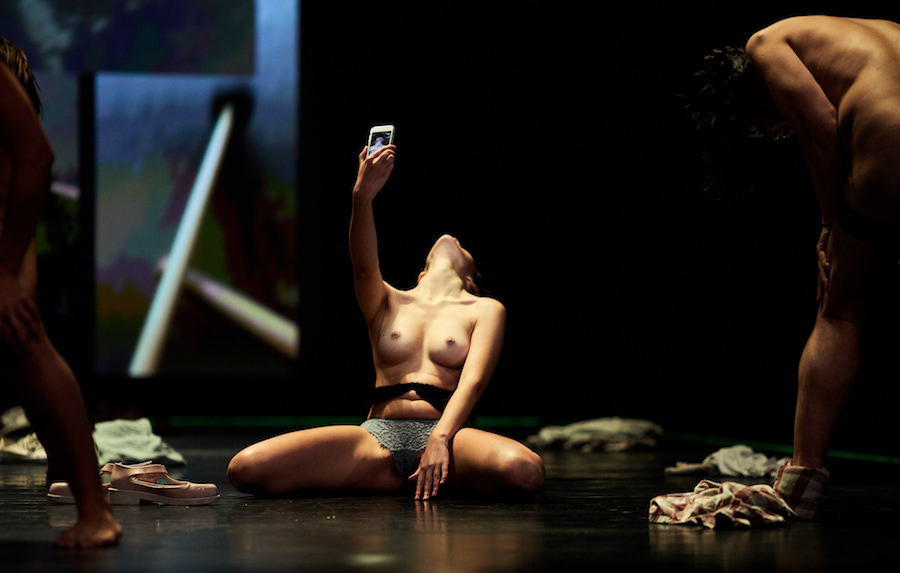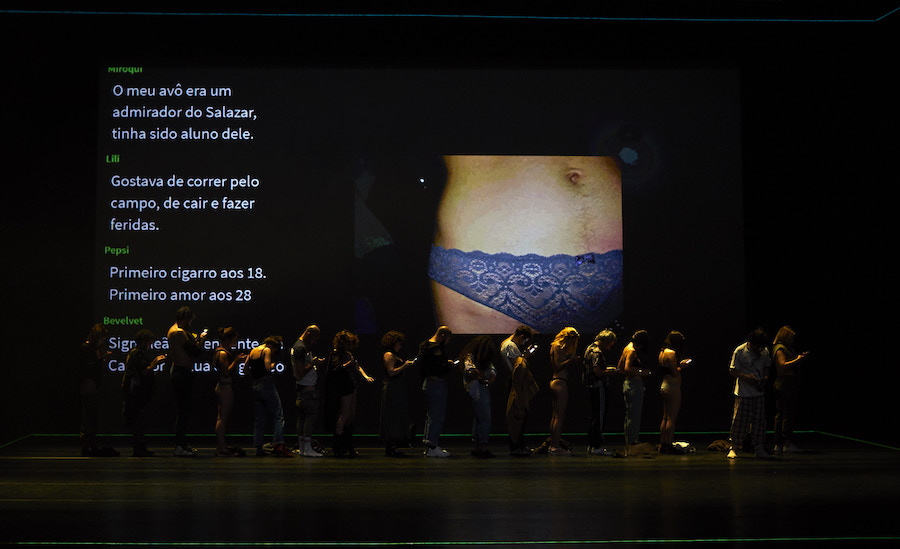FAMILY ROMANCE OR THE AUGMENTED REALITY, 2019
Selfies and chat rooms are Family Romance main source material. The performers are in a permanent state of presentation and exhibition of themselves by means of smartphone apps. All the messages and images take place on stage and are screened in real time.
Lodged in social and emotional affairs, virtual reality and social media are becoming the sole exclusive vehicle for communication, leaving their users in solitude. This emotional deadlock is the touchstone for Family Romance.
Family Romance is a landscape of solitude shared in a chat room.
Family Romance title was borrowed from a Japanese company of actors hired to act as friends and relatives of their clients.
Ana Borralho & João Galante are fascinated by the new communication technologies, not so much because of the increasingly impressive capacities that these have, or because of the attraction that each new gadget creates, but because of the way in which these technologies are transforming age-old social models and relations at an alarming rate. Whereas, until the twentieth century, audio-visual devices were designed for mass consumption, in the new millennium the focus is now placed on each citizen and their idiosyncrasies. The mass use of individualised digital equipment in every area is creating ways of life in which the notion of the social body has imploded and almost disappeared.
Family Romance or The augmented reality looks at these symptoms through the use of recent technological devices. What are the psychic effects of extreme individualisation? Is the real world at risk of becoming lost in the virtual world? Together with a group of the local community members, Ana Borralho & João Galante invite us to explore a future that has already begun.
Concept, Artistic and Space Direction: Ana Borralho & João Galante
Co-creation, Actors: Ana Freitas, Cláudio da Silva
Co-creation, Rehearsal Assistance & Performer: Alface (Cátia Leitão), Catarina Gonçalves
Co-creation, Technical Assistance & Performer: Tiago Gandra
Rehearsal Assistance & Performer: Daniel Matos
Performers: 10 participants from the local community - (Lisbon) Alexandre Crespo, André de Campos, Antonia Buresi, Barbara Bruno, Beatriz Garrucho, Eva Fornelos, João Meirinhos, Luara Learth, Maria Lalande, Mariana Santos e Ricardo Vaz Trindade
Dramaturgy, Artistic Collaboration: Fernando J. Ribeiro
Direction Assistance: Antonia Buresi
Light Design: Eduardo Abdala
Original Soundtrack: Coolgate aka João Galante
Multimedia Development: ArticaCC
Executive and Admin. Direction: Mónica Samões
Production and Touring Direction: Andrea Sozzi
Executive Production: Joana Duarte
Production: casaBranca
Co-Production: Fundação Caixa Geral de Depósitos - Culturgest, Le phénix pôle européen de création décentralisé au théâtre de Denain dans le cadre du Campus Amiens-Valenciennes avec le soutien du programme Culture pour tous du Ministère de la Culture et de la Communication
Support: Espaço Alkantara, Pólo Cultural Gaivotas, O Rumo do Fumo, Arisco - Instituição para a Promoção Social e da Saúde, Forall Phones, Pro.Dança-Escola de Dança e Produção de Espectáculos
Photography: © Vasco Célio






© Vasco Célio
Family Romance – a duel between intimacy and obscenity by Rui Catalão
In the last decade, the couple Borralho-Galante established an international community of thousands of people performing their stage work. Concealed in the crowd, we recognize a small core of associates that are part of their crew for a decade: Tiago Gandra, Cátia "Alface" Leitão, Catarina Gonçalves, Antonia Buresi, André Uerba, Cláudio da Silva, Ana Freitas. Amid the 18 people performing Family Romance, one by one they get onstage texting on the touchscreens of their smartphones. Without any substantial change in their routine they will undress in front of us, disclosing intimate parts of their bodies that conjure excruciating episodes of their lives. The apex of the performance ensues with them indulging in an act of debauchery, hosing each other with some 50 bottles of champagne. They start relating with the bodies of their colleagues as their own. As if, incidentally, they were still texting on the touchscreens of their smartphones.
If you are familiar with the music of Steve Reich, such as Drumming, you must remember the strangeness of listening to elemental rhythmic patterns, first played by a single musician, then two, followed by a third and a forth one, progressing in a growing richness of timbres with unprecedented sound frequencies. Much inspired by minimal music from their earliest performances, Borralho-Galante developed a strong visual style based on choral movements and naked bodies. More than choreographies, they were making "stage installation art." The bizarre would mingle with common gestures and repetition with slight variations.
The rhythm of their performances has always been slow. The dynamics is the result of accumulation and subtraction, similar to the tides of the ocean current. Family Romance distills and decants this way of building the scene. The sense of time and rhythm, the dramatic arc itself, is the product of tuning up. The performers evolve without seeming to change their routine of texting and taking selfies. Their isolation on stage rhymes with that of their colleagues. Solitude and rapport, orgy and withdrawal, fusion and dispersion. In cycles reminiscent of heartbeat periods, of systole and diastole, the group assembles and dissembles never interrupting the routine established at the beginning. They make contact never changing the impression of detachment.
“Everybody's so emotionally isolated that they don't even seem able to guess what they're missing”, said the critic Roger Ebert about Martin Scorsese's The King of Comedy. 36 years later the world has changed. The stars (meaning famous people) being chased by a crowd of fans was replaced by a crowd of anonymous stars chasing after their followers. It is no longer a question of studying characters so much obsessed with stardom to the point of alienating themselves from reality. What Family Romance presents is no longer an obsession with fame, but a landscape of people deluded with their own significance. People are together and indifferent to each other. They are absorbed in a fiction of their own. It is unsettling that this shared solitude observed in the play goes together with intimacy, almost to an endoscopic look at the body. This obsession with the “self” results in some kind of a Trojan horse giving access to the intimacy of people that remain strangers.
Throughout the career of the couple Borralho-Galante, we can recognize four periods in their work. Each new period absorbs the last one and adds a new layer. The early performances established an aesthetics of nudity and transgender codes, but with SexyMF (2006) and Untitled / Still Life (2009) the audience was already being pushed into the set. SexyMF was a face-to-face game of seduction between the performers and the spectators sitting in front of them, but Untitled / Still Life reversed the game. The audience was invited to join and take part. While they were allowed – if not even manipulated – to become the protagonists, the performers took the role of stewards inviting people to get on stage.
The third period of their work happened in 2011. In Atlas, the potential spectators of the play, in number of 100 people, were invited to take part in the rehearsals! This gesture of bringing the audience into the set, which had already been tested in previous works, had a stunning consequence. Amounting to a few dozens, Borralho-Galante audience began to fill rooms with hundreds of people. The couple added to their audience the friends and relatives of the volunteers taking part in Atlas, people that hardly were inclined, not to mention informed, to attend such acts.
Apart from enlarging their audience, Atlas also changed the way their work was being approached. It was not a question of arousing the “general public” with a bizarre imagery, but of compelling that newly found audience into what they were watching as something well known and familiar. The audience was not exactly being faced with artists, but with their relatives, friends and neighbors on stage. Those people were coming from their street and from their town. They represented the state of the community, a part of which was sitting in the audience.
Family Romance articulates these three periods added to their body of work. But, surprisingly, it breaks with an aspect that has been a constant in their aesthetics for two decades: the glance. In Borralho-Galante plays there is no fourth wall. The performers always look at the people in the audience. But in the case of Family Romance they only look at smartphones. They take selfies of the most intimate parts of their bodies; they write short messages addressing their private life; and finally share them on a platform projecting everything on a large screen.
Family Romance audience is invited to follow a sequence of images reminiscent of John Coplans unidentifiable self-portraits. But if these two channels (stage + pictures) are already close to fill the attention of the viewers, while they try to match the images according to the performers on stage, they will barely have time to follow the messages being scrolled. Written in real time, the messages are fragments of a larger story being told, and each of these personal narratives dissolves in a single fragmented choral narrative, that evokes Camilo José Cela’s novel, “The Hive”.
The spectator can choose to concentrate only on one of these channels (stage + pictures + text), but this would imply ignoring the experience they are invited to engage in. Why follow the performers on stage if they are only texting and taking pictures? But how can you invest in the sequence of pictures being showed and neglect the motions that generate those same images? What is the use of identifying the author of this or that picture if you are not paying attention to the narratives that add meaning to random images?
A show-hive, Family Romance evolves by the way of modules, fragments and ellipsis. Each performer creates a sequence of images and text corresponding to an autobiographical honeycomb. It’s their portfolio of self-portraits and personal narratives. But these individual narratives and pictures blend in and dissolve into one another. The performers expose their intimacy, but the spectator cannot identify them. With so many bees, you can only discern the hive.
No matter how self-centered the experience may appear, you can always indulge in putting together the pieces. What you will see in the end is but a funhouse mirror of yourself: your individuality, your image, your story, your significance. All your concerns regarding privacy and public image. The way it is represented and how it is represented. What survives is not the queen bee, but what is being produced in the hive: pictures and narratives of solitude. And just like yours, your neighbors’ solitude. Tenants of the same common hive.
The work being done by Borralho-Galante since 2002 does not allow Family Romance to be taken as an ironic look at intimacy. Their work has always been devoted to celebrating exposure and endorsing its sharing. In their plays, intimacy and nudity are not obscene precisely because they deactivate the psychic mechanisms that incite voyeurism and fear. Nudity and intimacy become touchstones for caring relationships. They are the cement that glue and protect individuals within the community. Obscenity, pornography and loneliness belong to those who lurk outside.
Family Romance by Fernando Ribeiro
Family Romance performance aims to reflect on the effects that the recent technological devices have on their users. Allowing a personalized and instantaneous manipulation, smartphones and laptops become the vehicles for perpetual communication fostered by selfies and messages, simultaneously launched to an infinitely close and distant cloud. Since its outbreak in the 19th century, the mechanization of life staged the most complete surrender by citizens, but always accompanied by defence strategies dealing with privacy and identity – and giving back a sense of scale before the immensity of the industrial and digital universe. Acting as intermediaries and protectors in the confrontation between atomized subjects and reality, technological screens become the exact place upon which all the experience of reality relies. Up until the twentieth century the audiovisual devices of popular consumption were directed to the masses, but in the new millennium the spotlight is given to one’s individual idiosyncrasies, giving them back a sense of identity. The term "identity" is now synonymous with the conversion of the body into an endless avalanche of images, archived and disseminated by apps through the cloud. The subjects are projected into media landscapes that simultaneously connect and isolate them until they are sent into a limbo where the whole notion of reality and social body implodes, finally reaching a state of pure abstractions.
Romance is reduced to an illusion, to bodies projecting themselves in unpredictable echoes – that remain imminent while the chat room is still active. Familiar will be a distant notion when the emotional onslaught is successively stagnated by selfies, transforming the social body into a room of mirrors. Artificial intelligence is incorporeal, intangible, visually neutral and its users build their identity according to the same model. If Family Romance manifests the ambivalence between the narcissistic posture and its projection in a volatile community, it does so only to subvert it, by readdressing both subjects and technological devices to a human dimension. When Reality is Augmented, the pornographic nature of alienation becomes explicit, not only in relation with the social fabric, but also dealing with the erotic and affective impulses of individuals. Making a tabula rasa of the performers' identities, Family Romance starts by mapping the organs and members of the bodies, even before they are seen naked. Without clothing, the bodies only find protection in others’ bodies. The meaning of Romance thus arises through a primordial solitude responsible for the sense of empathy. The spontaneous immersion in an erotic atmosphere ends up constituting the foundation for a community locus, whose constitution is as diaphanous as it is inexorable.
Family Romance enhances the passage from the individual to the universal, in a plan always haunted by the existential fissure pre-established in the technological devices. Any act of giving will be filtered by images and messages sent, not to the community, but to an imaginary audience. The truth of events takes place on stage, while the dramatization of actions is successively projected onto the screen. With the gestures - under the sign of selfies - belonging immediately to the audience, Family Romance ends up being situated in the interval of the forays of the bodies and the expectation generated by the images and narratives being shown on the screen; the realization of a sensus communis seams to appear imminent, and the hope for echoes beyond stage inscribes it in an infinitely distant utopia.